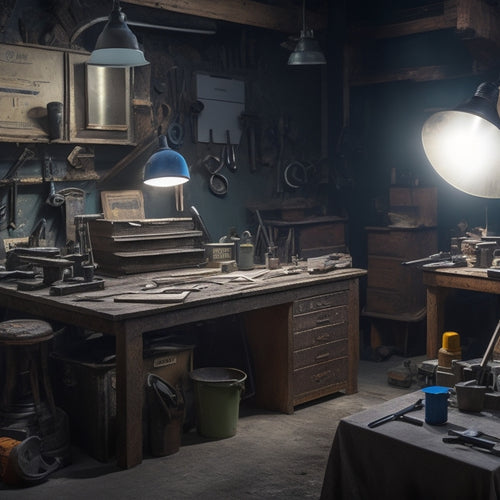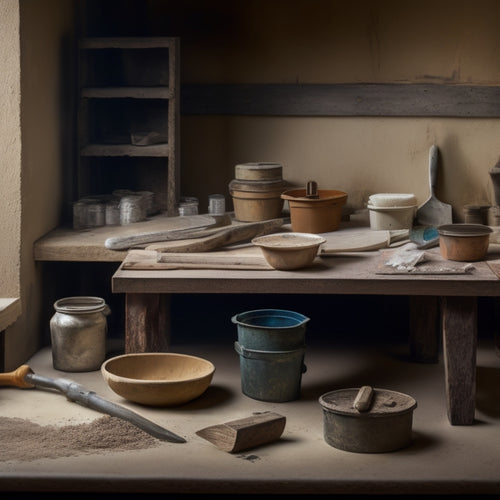
7 Best DIY Repair Kits for Home Renovation
Share
When selecting a DIY repair kit for your home renovation project, it's vital to take into account several factors to guarantee a successful and long-lasting repair. You'll need to choose the right concrete type, gather essential tools and equipment, and prepare the area properly. Evaluating product quality and price is also key, as well as taking necessary safety precautions. With so many options available, it's easy to get overwhelmed. By understanding the importance of each factor and avoiding common mistakes, you'll be able to select the best DIY repair kit for your specific project - and that's just the starting point for a successful renovation.
Key Takeaways
• Choose the right DIY repair kit based on the type of damage, such as polyurethane for small cracks and epoxy resin for larger repairs.
• Consider the price-to-quality ratio and material durability to ensure the best value for money.
• Follow the manufacturer's instructions and safety precautions for a successful repair.
• Prepare the area by cleaning and clearing debris to ensure a strong bond between the old and new materials.
• Consider factors like compressive strength, workability, and setting time when selecting concrete for a durable and long-lasting finish.
Choosing the Right Concrete Type
When tackling a home renovation project, your choice of concrete type ultimately determines the durability and longevity of your finished product. It's vital to select the right mix for your specific needs.
With numerous concrete types available, it's important to understand their characteristics and applications. You'll need to take into account factors like compressive strength, workability, and setting time to guarantee the concrete you choose meets your project's requirements.
For instance, high-strength concrete with a mix ratio of 1:2:4 (cement:sand:aggregate) is ideal for structural elements, such as foundations and beams, that require high load-bearing capacity.
On the other hand, self-consolidating concrete with a mix ratio of 1:1.5:2.5 is better suited for complex architectural features or areas with restricted access, as it flows easily and requires minimal vibration.
By selecting the right concrete type and mix ratio, you'll achieve a strong, durable, and long-lasting finish that withstands the test of time.
Take the time to research and understand the different concrete types and their applications to guarantee your home renovation project turns out exactly as you envisioned.
Essential Tools for Crack Repair
With a solid understanding of concrete types under your belt, it's time to tackle another crucial aspect of DIY home renovation: having the right tools for crack repair, as a well-stocked arsenal is necessary for achieving a seamless, long-lasting finish.
You'll need a variety of tools to tackle different crack types, from hairline cracks to deeper, more structural damage. A crack chaser or carbide-tipped saw blade will help you widen and clean out cracks, removing debris and old filler material. For smaller cracks, a caulk gun and acrylic or epoxy-based filler will do the trick.
For more extensive repairs, you'll need a mixing stick, bucket, and trowel to apply and smooth out patching compounds. Don't forget safety gear like gloves, goggles, and a dust mask to protect yourself from dust and debris.
Familiarize yourself with various repair techniques, such as injection, patching, and resurfacing, to guarantee you're using the right tools for the job. With the right tools and techniques, you'll be well-equipped to tackle even the most challenging crack repairs.
Preparation Is Key to Success
You'll greatly boost the chances of a successful crack repair by thoroughly preparing the area beforehand, clearing it of dirt, oil, and old filler materials that can compromise the bond between the old and new concrete. This vital step will save you time and money in the long run, guaranteeing a strong and durable repair that lasts.
To help you plan and prepare, consider the following factors:
| Factor | Considerations |
|---|---|
| Project Timeline | Allow extra time for preparation and drying before applying the repair kit |
| Cost Estimation | Factor in the cost of cleaning materials and any necessary equipment rentals |
| Surface Condition | Assess the extent of damage and plan your repair strategy accordingly |
| Weather Conditions | Schedule your repair for a dry, temperate day to guarantee ideal bonding |
DIY Concrete Repair Kit Options
Selecting the right DIY concrete repair kit for your specific project is essential, as different kits cater to various types of damage, from hairline cracks to larger holes and spalls.
You'll want to choose a kit that's designed for your specific issue, as using the wrong one can lead to subpar results or even further damage.
When it comes to concrete patching techniques, you'll need to evaluate the size and depth of the damage, as well as the surrounding surface. For smaller cracks, a polyurethane-based kit may be sufficient, while larger holes may require an epoxy resin application.
Epoxy resin kits are ideal for more extensive repairs, as they provide a strong, durable bond that can withstand heavy traffic and harsh weather conditions.
Be sure to follow the manufacturer's instructions carefully, and take necessary safety precautions when working with these products.
Evaluating Product Quality and Price
When evaluating DIY repair kits for your home renovation project, you'll want to take into account several key factors to guarantee you're getting the best value for your money.
You'll need to assess the durability of the materials, weighing their quality against the price tag to find the sweet spot where they intersect.
Material Durability Matters
Your DIY repair kit's success hinges on the quality of its materials, which is why it's vital to evaluate product durability and price before making a purchase.
When it comes to material selection, you want to choose kits that use high-quality, durable materials that can withstand the test of time. A longevity assessment is essential in determining whether the materials will hold up against wear and tear, weather conditions, and other environmental factors.
For instance, if you're looking to repair a leaky faucet, you'll want a kit that includes durable O-rings and gaskets that can resist corrosion and last for years to come.
Similarly, if you're repairing a crack in your wall, you'll want a kit that includes high-strength adhesives and durable patching compounds that can withstand the stress and strain of daily use.
Price-to-Quality Ratio
As you weigh your DIY repair kit options, carefully calculating the price-to-quality ratio is essential to guarantee you're getting the best value for your money. This ratio is significant in determining whether a product is a worthwhile investment or a costly mistake.
When evaluating the price-to-quality ratio, consider the cost efficiency of each kit. Are the materials of high quality, or are they cheap and prone to failure? Are you paying for features you don't need, or are you getting exactly what you require for your project?
Budget considerations are also important in this calculation. Set a realistic budget and stick to it, but don't sacrifice quality for the sake of saving a few dollars. Remember, a cheap kit may end up costing you more in the long run if it doesn't deliver the results you need.
Brand Reputation Counts
Researching a brand's reputation is a crucial step in evaluating product quality and price, since it can reveal valuable insights into the company's commitment to manufacturing reliable and durable DIY repair kits.
When you're considering a specific brand, you want to know if they've a history of producing high-quality products that meet customer needs. You can do this by reading customer reviews, checking ratings, and looking for certifications or awards that indicate excellence.
A brand with a strong reputation is more likely to have brand loyalty, which means customers keep coming back to them because they trust their products.
As you evaluate DIY repair kits, pay attention to the brand's reputation regarding customer satisfaction, product durability, and warranty or guarantee offerings.
A reputable brand will stand behind their products and provide support when you need it.
Safety Precautions to Take Seriously
As you commence your DIY home renovation project, remember that safety should always be your top priority.
You'll need to take certain precautions to avoid injuries and accidents, and it starts with you taking responsibility for your own safety.
Wear Protective Gear
You'll need to don the right protective gear before tackling any DIY home renovation project to shield yourself from potential hazards, including flying debris, toxic substances, and sharp objects. This isn't a step to be taken lightly, as even the smallest mistake can lead to serious injury or long-term health problems.
Start by investing in a good pair of protective gloves, which will provide a barrier between your skin and any sharp or rough surfaces you'll be working with.
Next, grab a pair of safety goggles to protect your eyes from flying particles or chemical splashes. Don't skimp on quality here – cheap goggles can shatter or fog up at the worst possible moment.
Additionally, consider a dust mask or respirator to keep airborne contaminants out of your lungs.
Check Power Tools
With your protective gear in place, turn your attention to the power tools that'll be essential in bringing your DIY home renovation project to life, but first, make certain they're in good working order and won't pose a threat to your safety. Regular power tool maintenance is vital to prevent accidents and guarantee peak performance. Before you start your project, inspect your tools for signs of wear and tear, frayed cords, or damaged blades. Make certain you're storing them properly in a dry, cool place, away from children and pets.
Here's a checklist to help you stay on track:
| Tool | Maintenance Tasks | Storage Solutions |
|---|---|---|
| Drill | Check for loose screws, clean drill bits | Store in a dry, cool place, away from direct sunlight |
| Circular Saw | Inspect blade for damage, clean sawdust | Hang from a hook or store in a protective case |
| Sander | Check for worn-out sandpaper, clean dust collector | Store in a sealed container, away from moisture |
| Hammer | Inspect handle for cracks, clean head | Hang from a hook or store in a toolbox |
Clear Work Area
Before starting your DIY home renovation project, clear the work area of any clutter, tripping hazards, and combustible materials to create a safe and efficient workspace. This vital step guarantees you can focus on the task at hand without worrying about accidents or distractions.
Start by removing any unnecessary items from the area, including furniture, rugs, and decorations. Next, identify and eliminate tripping hazards, such as cords, wires, and uneven flooring.
Implementing effective workspace organization strategies will help you stay focused and productive throughout the project. Consider designating specific zones for different tasks, like a tool station or a material storage area. Decluttering strategies, such as sorting items into categories or using storage bins, can also help maintain a tidy workspace.
Common Mistakes to Avoid Completely
When tackling a DIY home renovation project, overlooking crucial details can lead to costly mistakes, so it's important to identify and avoid common pitfalls that can derail your entire project.
One of the most critical mistakes you can make is poor budget planning. You'll need to set a realistic budget and stick to it to avoid financial strain. Failing to plan your project timeline can also lead to delays and increased costs. Make certain you create a detailed schedule and milestones to keep your project on track.
Another mistake to avoid is not preparing for the unexpected. Renovations often uncover hidden problems, such as structural damage or electrical issues. Having a contingency plan and budget will help you tackle these surprises without derailing your project.
Additionally, don't underestimate the importance of quality materials and tools. Using subpar materials can lead to substandard results, and investing in the right tools will make the job easier and more efficient.
Frequently Asked Questions
Can I Use DIY Repair Kits on Freshly Poured Concrete?
When you're dealing with fresh concrete, it's important to wait before applying DIY repair kits.
You should allow the concrete to fully cure, which can take anywhere from 24 hours to 28 days, depending on the mix and environmental conditions.
Premature application can compromise the repair kit's effectiveness, leading to weak bonds and further damage.
Be patient, and only apply the kit once the concrete has fully hardened to guarantee a strong and lasting repair.
Are DIY Concrete Repair Kits Suitable for Large-Scale Projects?
You're not trying to hold back a tsunami with a broken reed, but you're wise to wonder if DIY concrete repair kits are suitable for large-scale projects.
While they're perfect for small cracks and crevices, they've project limitations.
For large scale applications, you'll need industrial-strength solutions that can withstand immense pressure and stress.
Don't risk your entire project by relying on a DIY kit; instead, opt for professional-grade materials designed for massive undertakings.
Will DIY Repair Kits Match the Color of My Original Concrete?
When you're repairing concrete, you'll want to guarantee the DIY kit matches the original color and surface texture.
You'll need to select a kit that offers color matching options, as a mismatch can be eye-catching.
Additionally, consider the texture of your original concrete - is it smooth, rough, or stamped?
Choose a kit that can replicate this texture to achieve a seamless blend.
Can I Use DIY Repair Kits on Vertical or Overhead Surfaces?
'Practice makes perfect' and when it comes to using DIY repair kits on vertical or overhead surfaces, you'll need to perfect your application techniques.
Start by ensuring proper surface preparation, as a strong bond relies on a clean and dry surface.
Apply the repair compound in thin layers, working from the bottom up to prevent drips.
For overhead surfaces, use a putty knife or trowel to spread the compound, feathering it out towards the edges.
Do DIY Repair Kits Come With a Warranty or Guarantee?
When you invest in a DIY repair kit, you'll want to know if it comes with warranty options that back up the product's durability.
Typically, reputable manufacturers offer some form of guarantee, ranging from a few months to a lifetime warranty.
Be sure to check the fine print, as some warranties may require registration or have specific conditions.
You'll have peace of mind knowing you're protected in case the product fails or doesn't meet your expectations.
Conclusion
As you commence your home renovation journey, remember that a little TLC (tender loving care) can go a long way in salvaging your cracked concrete surfaces.
By investing in the right DIY repair kit and following some simple yet essential steps, you'll be saying goodbye to those unsightly cracks and hello to a refreshed, revitalized space that's as good as new.
So, take a deep breath, roll up your sleeves, and get ready to breathe new life into your home.
Related Posts
-

Create a Home Renovation Project Timeline in Excel
You can create a detailed home renovation project timeline in Excel by setting up a tailored template with separate w...
-

What to Inspect When Buying Used Renovation Tools
When buying used renovation tools, you need to scrutinize every detail to avoid costly mistakes. Inspect for rust and...
-

Top 5 Plastering Tools for Small Renovation Jobs
For small renovation jobs, you'll want to start with the top 5 crucial plastering tools: a putty knife for applying a...


